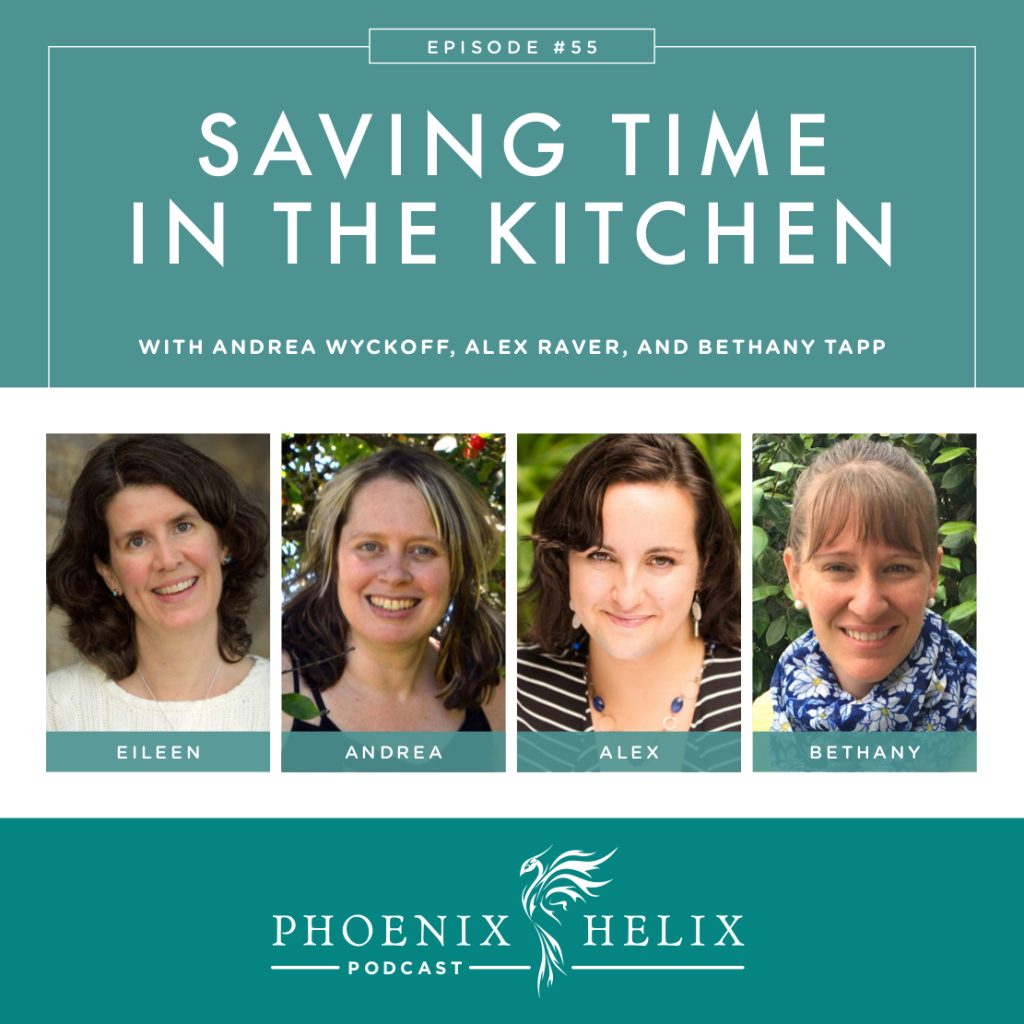
Tips and Tricks from Experienced Cooks
Life on a healing diet means preparing most – if not all – of your own food. So, that’s a lotta cooking! Anything that saves us time and makes the process more efficient is a lifesaver. It’s also an important part of being able to stick with a healing diet. In this podcast episode, I have 3 wonderful guests. Together we’ll be sharing our best tips for making the most food in the least amount of time, without sacrificing nutrition or flavor.
Listen to the Show
- Subscribe to my podcast through your favorite podcast app: iTunes, Stitcher, Google, TuneIn, Spotify, Amazon, etc.
- You can also listen to the episode right here through the player below, and if you subscribe to my newsletter you’ll get notified of future episodes.
Podcast: Play in new window | Download
Show Notes
- Intro (0:00)
- Thank You to Our Podcast Sponsor – Paleo on the Go (2:01)
- A frozen meal delivery service, they have a large menu of items for the paleo autoimmune protocol (AIP).
- Use the code PHOENIX for 10% off your first order.
- Meet Our Guests (3:01)
- Alex Raver is the blogger behind Don’t Eat the Spatula. She follows the paleo autoimmune protocol (AIP) to manage PCOS. She was hospitalized at age 19 while studying abroad in France. She needed emergency surgery to remove an infected cyst, and this led to her diagnosis. However, she had been having symptoms for years, including unexplained weight gain, skin discoloration, and painful menstrual cycles. She was put on hormone medication which unfortunately made her symptoms worse. She was also told she would never be able to conceive a child, because infertility is common with PCOS. At age 29, she began eating AIP and working with a functional medicine practitioner to balance her hormones. 9 months later, she got pregnant and has a beautiful baby girl. In addition to diet, stress management has been essential to keeping her hormones and her health in balance.
- Andrea Wyckoff is the former blogger behind Forest and Fauna. She used a low-starch paleo diet to put ankylosing spondylitis (AS) and colitis into remission. She suffered from back pain throughout her teens and early 20’s and in spite of seeing numerous specialists, was never accurately diagnosed. She took NSAIDs daily to manage the pain, and at age 28 she developed severe colitis. This led to rapid weight loss and the inability to work. Doctors brushed it off as IBS. It wasn’t until her chiropractor took x-rays and noticed that her spinal bones had fused together through a large portion of her spine that she was finally diagnosed with AS at age 30. She had lost 3 inches in height during those years she was undiagnosed. This was before paleo was well-known, but she did some research and pieced together a healing diet very similar to paleo. She gave up wheat, dairy, soy and corn first, and eventually starches once she learned they are specifically connected to the AS diagnosis. Her colitis went away altogether, and her AS went into remission, preventing the damage from progressing to her neck. After being on this healing diet for 10 years, she succeeded in reintroducing many foods just this past year, including starches and gluten-free grains. Her biggest flare triggers (and the foods she continues to avoid) are nightshades, soy, and cow dairy. She’s also choosing not to reintroduce gluten.
- Bethany Tapp is the former blogger behind Adventures in Partaking. She follows the AIP to manage spondylarthritis, uveitis and endometriosis. Bethany’s symptoms also started in her teens. She experienced chronic lower back pain and excruciating pain with her menstrual cycle. She also took high doses of NSAIDs to manage the pain. Doctors told her it was all in her head, that she was just experiencing growing pains. The pain continued into her 20’s, with some months being worse than others. At age 33, she had surgery for an ovarian cyst and they found endometriosis. That was her first diagnosis. She was put on medication but had a negative reaction, so she searched for a dietary solution. She gave up gluten, dairy, soy, sugar and meat, and her endometriosis symptoms disappeared completely. However, her energy levels plummeted, her back pain returned, and she developed a new symptom – excruciating eye pain. An ophthalmologist diagnosed her with uveitis and referred her to a rheumatologist, who eventually diagnosed her with spondylarthritis. This is similar to AS, but without the spinal fusion. When the rheumatologist recommended immunosuppressants, Bethany started the AIP instead. This meant adding meat back into her diet and removing all grains. She responded so well to the diet that she was able to go off her painkillers and avoid immunosuppressants altogether. She has also found two other things essential to her wellness: getting 8-9 hours of sleep each night, and exercising in a way that feels good to her body.
- Batch Cooking (26:53)
- What Is It? This is a technique where you prepare a lot of meals in a short period of time, and you can eat them throughout the week or freeze them for later use. The simplest method of batch cooking is simply to double or triple whatever you’re cooking. For example, if you’re going to roast a chicken, roast two of them. If you’re roasting vegetables, roast as many pans as will fit on both racks in your oven, rotating them halfway-through. If you’re making sausage patties, make anywhere from 2 to 5 pounds at once. You can store them in the freezer separated by parchment paper, and cook them as you need them.
- Bethany: When she was a nanny for a family with 5 children, she and the mother of the family did “once-a-month” meal preparation. They took one Saturday to meal plan, choosing the recipes and coming up with a complete grocery list for all the meals, along with a work chart for batch cooking day. Then on another Saturday, they would start early in the morning and slowly stock the freezer. They prepared pre-cooked meats and pre-chopped vegetables that could be used in many meals, as well as labeled bags of complete meal ingredients for quick skillet meals, soups & stews, slow cooker meals, as well as prepared casseroles that only needed to be popped into the oven later in the month.
- Alex: Since she has histamine intolerance, she batch cooks in special ways. Rather than eating leftovers throughout the week, she’ll freeze the extra portions immediately after cooking, which halts the histamine development. She also loves to batch cook and freeze vegetable soup as a base. Then, she can defrost the soup later and add meat and more vegetables for a complete meal. Two of her favorite soup recipes are this Creamy Mushroom Soup, and also the Golden Beet and Caramelized Leek Soup in the new Paleo AIP Instant Pot Cookbook.
- Andrea: She likes to batch prep vegetables for salad and also prepare dressings, sauces and condiments in advance, so she has a wide variety of flavors at her fingertips. Some of her favorites are Green Goddess Dressing, No-Peanut Sauce, and the Cranberry BBQ Sauce in the new Paleo AIP Instant Pot Cookbook. She also likes to batch cook and freeze breakfast foods, to save time in the mornings. She keeps a stash of bone broth and comforting soup in the freezer for days when she’s not feeling well. And since she’s reintroduced white rice back into her diet, she batch cooks that as well. One more way Andrea saves time is by bulk buying directly from farmers, so she doesn’t need to go to the grocery store as often.
- Eileen: She also loves batch prepping all of her vegetables for the week on farmers market day, and she uses Fridgesmart Containers to keep the vegetables fresh in the fridge for a much longer period of time. And her favorite batch cook breakfast is this Homemade Chicken Soup.
- Other Resources:
- AIP Batch Cook – a video tutorial which includes recipes and meal plans. This is great for beginners.
- The Healing Kitchen Cookbook – contains two weeks of batch cooking meal plans using the recipes in the cookbook.
- The Instant Pot – “Fast Food” on a Healing Diet (46:26)
- What Is it? The Instant Pot is 7 appliances in one: a pressure cooker, a slow cooker, a rice cooker, a yogurt maker, a steamer, a warmer, and it even has a sauté function allowing for one-pot meals. It’s most famous for its pressure cooker function, and that’s what we’re talking about on the podcast today.
- The Paleo AIP Instant Pot Cookbook has taken Instagram by storm this week. I (Eileen) am the editor of the e-cookbook, and I invited 36 bloggers to submit recipes. Together, we came up with 141 recipes including Broths, Sauces, Condiments, Vegetables, Poulty, Meat, Seafood, Organ Meat, Dessert, and Extras. If you have an Instant Pot, your world just got a little better. If you don’t have one yet, you might want to add it to your wish list.
- Bone Broth: Many of us fell in love with the Instant Pot for bone broth alone. You can make 24 hour gut-healing bone broth in just 2 hours.
- Andrea: Eileen loved Andrea’s recipe for Instant Pot Swedish Meatballs with Mushroom Gravy so much that she chose it as a preview recipe for the cookbook. One of the things Andrea loves most about the Instant Pot is the stainless steel insert. It’s easy to clean, lightweight, and small enough to store in the fridge.They even sell a silicone lid to keep your leftovers airtight. She cooks in her IP about 5 times a week, sometimes twice a day. Andrea also loves that when your meal has finished cooking, you don’t have to get up and deal with it right away. The machine will switch to a “keep warm” setting, naturally depressurize, and stay warm for up to 10 hours.
- Alex: Since she has histamine intolerance, she does better with fast-cooked rather than slow-cooked food. So, she loves the pressure cooker function of the Instant Pot. She doesn’t do well with 24-hour bone broth, but her body loves pressure-cooked bone broth. When she started experimenting with the IP, the first recipe she created came out great: Easy Healing Chicken & Vegetable Soup. For her family, the Instant Pot is a weeknight savior, because it cooks meals so quickly. It even cooks frozen meat in the same amount of time as thawed meat. It just takes a little longer to come to pressure. Alex also loves cooking Spaghetti Squash in the Instant Pot, because it saves so much time and precious oven space on batch cooking day. In fact, she recommends doing batch cooking with your Instant Pot and leaving your oven off altogether. One of her favorite recipes for this is Fall Off the Bone Whole Chicken.
- Bethany: She lives in Dubai where the Instant Pot isn’t available, so she has been adapting Instant Pot recipes to her stovetop pressure cooker. She finds that the recipes translate really well. You just need to know how your brand of pressure cooker works and adapt accordingly.
- Eileen: Tip: If you cook in your Instant Pot back-to-back, always remove the sealing ring between recipes and dry both the ring and the lid completely. Otherwise, it might interfere with your pot’s ability to build up and maintain pressure.
- Shoutout to Laura Vein who did the interior design, Kate Jay who photographed the cover, and Chelsey Luther who designed the cover. Laura was living in South Texas when we were working on this cookbook, and one of her favorite features of the Instant Pot is that it doesn’t heat up the kitchen, which is especially nice in warm climates.
- Slow Cookers (1:08:02)
- Slow cookers aren’t fast, but they are easy. They let you prep your dinner in the morning and it cooks while you’re away, with no need to watch over the meal. I have a Slow Cooker Recipe Roundup with 50 Paleo AIP recipes.
- The Instant Pot also has a Slow Cooker function, which we love. Tip: on the Instant Pot, the default setting for Slow Cook is “Normal”. This is equal to “Low” on a traditional slow cooker. “More” is equal to “High” on a traditional slow cooker. Don’t ever use the “Less” setting on the Instant Pot when you slow cook, or it will take 12-24 hours to cook your meal.
- Outro (1:09:30)
- Bethany is the the author of My Paleo AIP Indian Adventure. She has retired from food blogging.
- Andrea also retired from food blogging in 2022.
- Alex blogs at Don’t Eat the Spatula.
- Eileen (your podcast host) is the author of multiple books, written to help people thrive with autoimmune disease. Learn more on the Books Page.
- If you like this podcast, follow or subscribe through your favorite podcast app. You can also subscribe to Eileen’s biweekly newsletter.
- Check out the entire archive of podcast episodes.
You May Also Be Interested In
Spreading the Word
If you like the podcast, please leave a positive review in iTunes. It would mean the world to me, and also helps others find the podcast. Here are some quick instructions using your iPhone:
- If you are already subscribed to my podcast: (1) Click the purple podcast icon. (2) At the bottom of the screen, click Library. (3) At the top of the screen, click Shows. (4) Click the Phoenix Helix podcast image. (5) Scroll down the page, and you’ll see Ratings and Reviews. Scroll down a little bit more and click on Write a Review. This will bring up the review screen. Tap 5 stars (if you love the podcast), and then click in the title box, and it will bring up the keyboard. Enter a title and short review. (6) Click Send in the upper right corner. (7) Thank you! Positive reviews give the podcast a higher search ranking in iTunes, helping people find it and letting them know it’s a quality podcast and worth their time to listen.
- If you haven’t subscribed to my podcast: (1) Click the purple podcast icon. (2) In the lower right corner, click the magnifying class. (3) Type Phoenix Helix in the search box. (4) Click the podcast cover in the Show list. (5) If you’d like to subscribe, click the + sign at the top of the screen. (6) To write a review, scroll down the page, and you’ll see Ratings and Reviews. Scroll down a little bit more and click on Write a Review. This will bring up the review screen. Tap 5 stars (if you love the podcast), and then click in the title box, and it will bring up the keyboard. Enter a title and short review. (7) Click Send in the upper right corner. (8) Thank you! Positive reviews give the podcast a higher search ranking in iTunes, helping people find it and letting them know it’s a quality podcast and worth their time to listen.

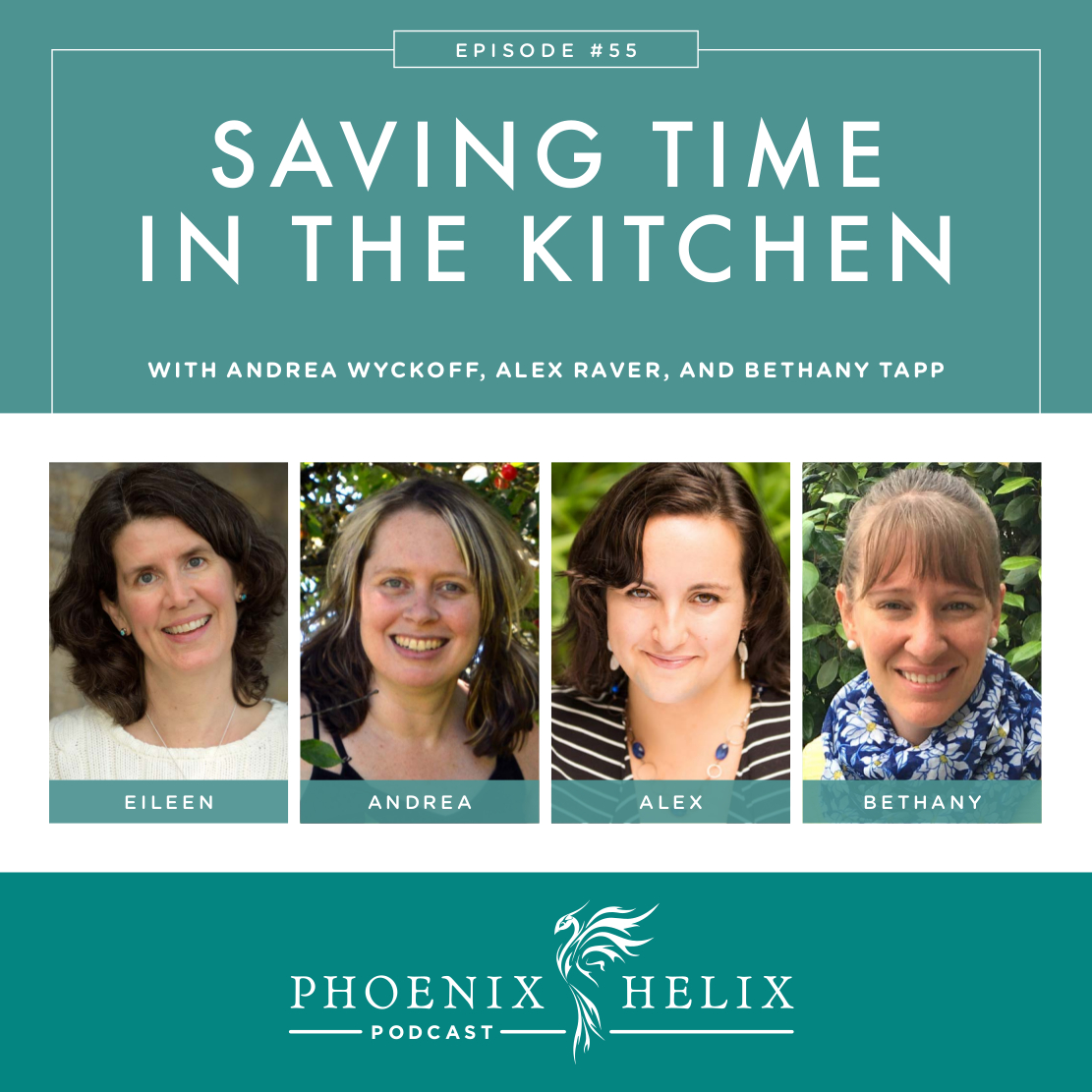


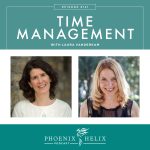

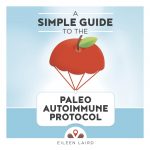
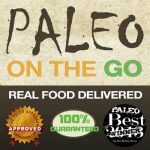

Thanks for the fantastic tips! I think I need a bigger fridge and freezer…
Having a second freezer makes such a difference! Something for the wish list.
I just bought the second freezer. Yippee!
Congratulations! You’re gonna love it.
I am 24 years old and the eldest of 5 siblings. Two years ago, our mother (45 at the time) was diagnosed with non-smoking COPD. She began the Wahls Protocol the year before. After the diagnosis, as a family we did the GAPS protocol, gradually merging into AIP.
Preparing three GAPS/AIP meals a day for 7 people over the age of 15 is no joke, so we found this podcast quite useful. It took the first 6 months for us to begin fine-tuning our system. We’ve learned a lot in the past couple years. The five of us completely run the house, and together we now spend about 7 man-hours a day in the kitchen with washing dishes (we don’t have a dishwasher) and meal prep. (This includes Papa’s AIP lunches that he totes to work on a train, then on a 2 mile walk in the city.). We’ve started freezing whole meals, freezing sauces, and freezing cooked onion and spice mixtures. On your recommendation we bought both the Instant Pot and your cookbook. It makes the best bone broth. And, for my mother, I make vegetable juices, fermented orange/grapefruit juice and the Raspberry Avocado Pudding from Autoimmune Wellness by Mickey Trescott and Angie Alt. The juices I make monthly and the pudding weekly; and then I freeze them in individual-size servings. The Cuban Style Picadillo and the Pastitsio Pie, from our favorite cookbook Nourish by Rachael Bryant, makes wonderful freezer meals. So does Parsnip Cassava Gnocchi with N’omato meat sauce. Mama is working hard to gain weight, so basically every time she opens her mouth, we have something ready to chuck in!
Thank you for sharing these AIP cooking tips and for the healing stories! They encourage us and give an added hope for Mama’s future.
Mary, wow! What an amazing family. Thank you so much for sharing your story and your tips, including your favorite recipes!
Hi, this podcast is full of useful resources–thanks! Appreciated ‘meeting’ your guests, and I like that you always begin with your 3 questions.
Do you know of a good, comprehensive resource about how to thaw different foods from the freezer to retain best texture? Are some things cooked better straight from frozen?
Great question, Holly! I don’t know of such a resource, but I’m sure there are some freezer-focused blogs out there. Do a Google search, and you can adapt their advice to paleo foods.
Once again, another intriguing podcast that also sold us on the Instant Pot. My children do all of the family cooking, and this particular episode still has them talking. The personal stories helps us all keep our perspective.
After looking through the recipe list for your new e-cookbook, I remembered a question I’ve long had, but never took the time to ask: what brand of balsamic vinegar is AIP? I cannot have alcohol in any amount or of any kind, and the balsamic vinegars I find either have grape must/wine vinegar. Maybe I need to splurge on the fancy stuff?
Hi Sarah. I’m so glad your family enjoyed the podcast, and I love that your children cook the family meals! Balsamic vinegar is made from wine, but my understanding is there is only trace alcohol remaining by the time it has turned into vinegar, which is why it’s allowed on the AIP. This is true for all brands of balsamic and other wine vinegars.
Oh, I loved this podcast: the beginning – those amazing stories of healing, the middle – tips and tricks for time-saving, through to the end – Instant Pot inspiration.
To the Instant Pot notes, I’d just like to add that we use ours daily for steaming vegetables. I set the ‘steam’ function to just 2 or 3 minutes, and quick release the pressure when the timer sounds. Perfect veggies, always!
Angie, awesome tip! Thanks for sharing.